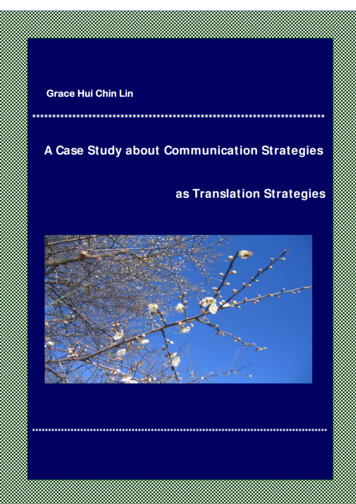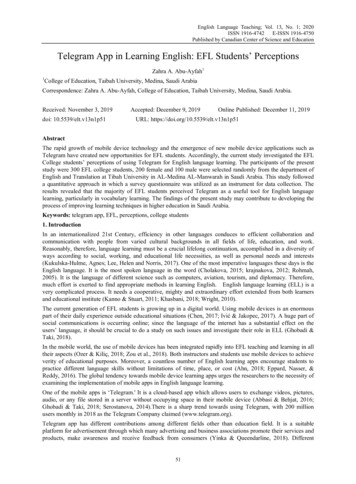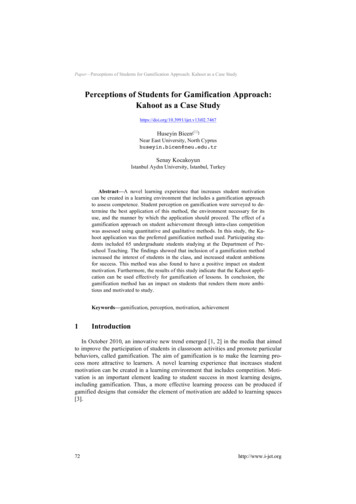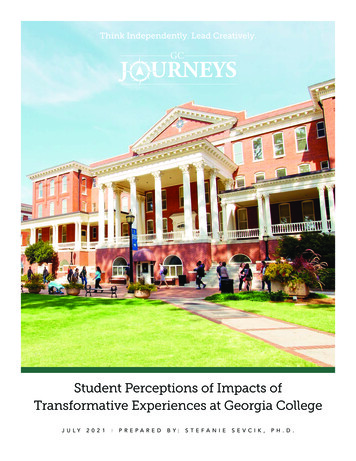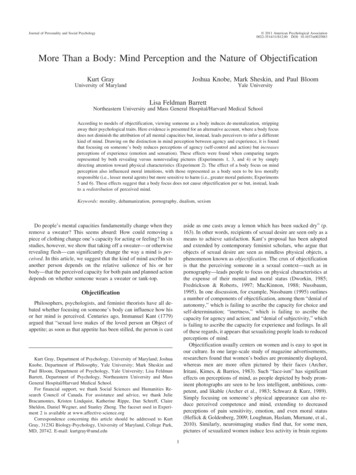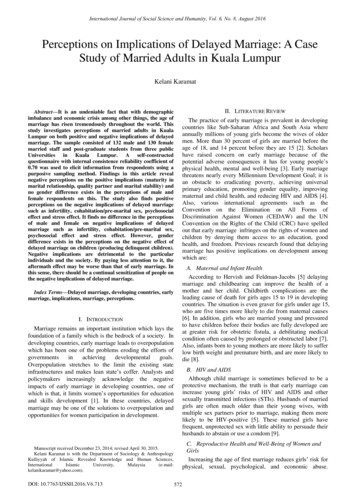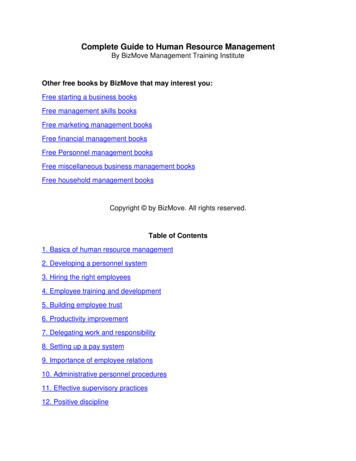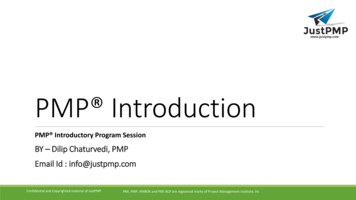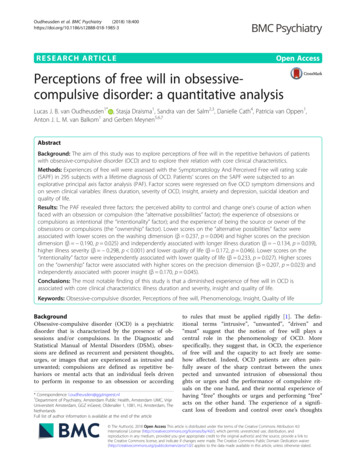
Transcription
Oudheusden et al. BMC Psychiatry(2018) EARCH ARTICLEOpen AccessPerceptions of free will in obsessivecompulsive disorder: a quantitative analysisLucas J. B. van Oudheusden1* , Stasja Draisma1, Sandra van der Salm2,3, Danielle Cath4, Patricia van Oppen1,Anton J. L. M. van Balkom1 and Gerben Meynen5,6,7AbstractBackground: The aim of this study was to explore perceptions of free will in the repetitive behaviors of patientswith obsessive-compulsive disorder (OCD) and to explore their relation with core clinical characteristics.Methods: Experiences of free will were assessed with the Symptomatology And Perceived Free will rating scale(SAPF) in 295 subjects with a lifetime diagnosis of OCD. Patients’ scores on the SAPF were subjected to anexplorative principal axis factor analysis (PAF). Factor scores were regressed on five OCD symptom dimensions andon seven clinical variables: illness duration, severity of OCD, insight, anxiety and depression, suicidal ideation andquality of life.Results: The PAF revealed three factors: the perceived ability to control and change one’s course of action whenfaced with an obsession or compulsion (the “alternative possibilities” factor); the experience of obsessions orcompulsions as intentional (the “intentionality” factor); and the experience of being the source or owner of theobsessions or compulsions (the “ownership” factor). Lower scores on the “alternative possibilities” factor wereassociated with lower scores on the washing dimension (β 0.237, p 0.004) and higher scores on the precisiondimension (β 0.190, p 0.025) and independently associated with longer illness duration (β 0.134, p 0.039),higher illness severity (β 0.298, p 0.001) and lower quality of life (β 0.172, p 0.046). Lower scores on the“intentionality” factor were independently associated with lower quality of life (β 0.233, p 0.027). Higher scoreson the “ownership” factor were associated with higher scores on the precision dimension (β 0.207, p 0.023) andindependently associated with poorer insight (β 0.170, p 0.045).Conclusions: The most notable finding of this study is that a diminished experience of free will in OCD isassociated with core clinical characteristics: illness duration and severity, insight and quality of life.Keywords: Obsessive-compulsive disorder, Perceptions of free will, Phenomenology, Insight, Quality of lifeBackgroundObsessive-compulsive disorder (OCD) is a psychiatricdisorder that is characterized by the presence of obsessions and/or compulsions. In the Diagnostic andStatistical Manual of Mental Disorders (DSM), obsessions are defined as recurrent and persistent thoughts,urges, or images that are experienced as intrusive andunwanted; compulsions are defined as repetitive behaviors or mental acts that an individual feels drivento perform in response to an obsession or according* Correspondence: l.oudheusden@ggzingeest.nl1Department of Psychiatry, Amsterdam Public Health, Amsterdam UMC, VrijeUniversiteit Amsterdam, GGZ inGeest, Oldenaller 1, 1081, HJ, Amsterdam, TheNetherlandsFull list of author information is available at the end of the articleto rules that must be applied rigidly [1]. The definitional terms “intrusive”, “unwanted”, “driven” and“must” suggest that the notion of free will plays acentral role in the phenomenology of OCD. Morespecifically, they suggest that, in OCD, the experienceof free will and the capacity to act freely are somehow affected. Indeed, OCD patients are often painfully aware of the sharp contrast between the unexpected and unwanted intrusion of obsessional thoughts or urges and the performance of compulsive rituals on the one hand, and their normal experience ofhaving “free” thoughts or urges and performing “free”acts on the other hand. The experience of a significant loss of freedom and control over one’s thoughts The Author(s). 2018 Open Access This article is distributed under the terms of the Creative Commons Attribution 4.0International License (http://creativecommons.org/licenses/by/4.0/), which permits unrestricted use, distribution, andreproduction in any medium, provided you give appropriate credit to the original author(s) and the source, provide a link tothe Creative Commons license, and indicate if changes were made. The Creative Commons Public Domain Dedication o/1.0/) applies to the data made available in this article, unless otherwise stated.
Oudheusden et al. BMC Psychiatry(2018) 18:400and actions lies at the heart of the suffering of OCDpatients [2].The concept of free will has been studied and debatedextensively by philosophers for the past two millennia[3]. Although these studies have given rise to many different perspectives, Walter [4] discerns three mainaspects of free will in the contemporary philosophicaldebate. According to his interpretation, acting out offree will can be conceived of in the following ways: 1.having the ability to act otherwise, that is, having alternative possibilities open to one; 2. acting or choosing for(understandable) reasons, which implies intentional behavior; 3. being the owner or (causal) source of one’s actions [5].When discussing conditions of diminished freedom,philosophers often invoke mental disorders – andOCD specifically – as examples. Regarding OCD,Levy [6] writes:We understand that a person suffering fromobsessive-compulsive disorder, spending all daywashing his hands and checking dozens of timesthat he remembered to lock the front door, cannotbe thought of as having free will. His actions aremechanically dictated by stereotyped scripts, fromwhich he cannot escape. Thus, obsessive-compulsivedisorder is a malady of free will.Given the importance of the experience of (diminished) free will in OCD phenomenology, it is surprisingthat the topic has received little attention in empiricalresearch. The present study is designed to address thisgap in the literature. Thus, our main aim is to shed newlight on what it means to be obsessed and to be compelled in the context of OCD, by exploring perceptionsof free will in patients with OCD using insights derivedfrom the philosophy of free will. Having a clearer viewon these perceptions might encourage professionals toexplore the experiential realm of their patients withthem, in addition to the more standard diagnostic approach of assessing symptoms, illness severity, symptomsubtypes and comorbidity. The second aim of our studyis to explore the clinical significance of free will experience in OCD. Because OCD is a heterogeneous disorderwith respect to its thematic content, we first investigatedthe association between different OCD symptom dimensions and experiences of free will. Furthermore, weassessed the association between experiences of freewill and seven clinical variables that were selectedbased on the a priori hypothesis that they might influence, or be influenced by, experiences of free will: illness duration, OCD severity, insight, severity ofcomorbid anxiety and depression, severity of suicidalideation and quality of life.Page 2 of 9MethodsDesign and settingThe present study is embedded within the NetherlandsObsessive Compulsive Disorder Association (NOCDA)study, a multicenter naturalistic cohort study designedto investigate the long-term course and outcome inOCD. The study design and baseline characteristics ofthe study sample are described in detail elsewhere [7]. Inshort, at baseline, we included 419 patients with a lifetime diagnosis of OCD, as determined by the administration of the Structured Clinical Interview for DSM-IVAxis I Disorders (SCID-I) [8]. Baseline measurementstook place between 2005 and 2009 and included validated semi-structured interviews and self-report questionnaires to gather information on a broad range ofvariables related to (amongst others) OCD, comorbidityand psychosocial consequences. All included participantswere contacted at 2-, 4- and 6-year follow-up, irrespective of their treatment status. The rating scale used toassess free will experience (see below) was administeredduring the 4-year follow-up wave, in which 295 subjectsparticipated. The study was approved by the MedicalEthical committee of the VU Medical Centre,Amsterdam.QuestionnaireThe Symptomatology And Perceived Free will ratingscale (SAPF) is a self-report questionnaire that operationalizes and applies insights from the philosophy of freewill as captured in the conceptual framework by Walter[see introduction] to the study of psychopathology. Itwas originally developed by Van der Salm et al. to studyperceptions of free will in a range of movement disorders, including tic disorder [9]. The fifteen items thatmake up the questionnaire all capture different aspectsof free will experience. Because tic disorder and OCDshare several important features with regard to phenomenology, comorbidity, underlying neurobiology andtreatment strategies [10, 11], the SAPF was consideredto be a suitable starting point for the exploration of freewill perceptions with regard to obsessive-compulsivebehavior. For this study, the wording of the fifteen itemswas adapted to enable specific application to obsessionsand compulsions, without altering any further content.The questionnaire starts by asking the patient whetherhe or she suffers the most from obsessions or fromcompulsions. The patient is then requested to fill in thequestionnaire with his or her most prominent symptomin mind. Answers to all but one of the questions aregiven on a Visual Analogue Scale, ranging from 0 (“notat all”) to 100 (“completely”). For the present analysis,we excluded one question that was dichotomous innature and three questions that dealt with generalperceptions of free will and not with symptom-specific
Oudheusden et al. BMC Psychiatry(2018) 18:400experiences, leaving 11 items. See Fig. 1 for the individual items.Clinical characteristicsThe Padua Inventory-Revised (PI-R) [12, 13] was used toassess the presence and severity of five OCD symptomdimensions: (I) impulses, (II) washing, (III) checking, (IV)rumination and (V) precision. Illness duration was definedas the interval between the age at interview and thereported age at onset of OCD as assessed with the SCID-1[8]. Severity of obsessive-compulsive symptoms wasmeasured with the Yale-Brown Obsessive-CompulsiveSeverity Scale (Y-BOCS; Range 0–40; Cronbach’s α for thissample: 0.926) [14]. The degree of insight into OCDsymptoms was assessed with the Overvalued Ideas Scale(OVIS; Range 0–10; Cronbach’s α: 0.663) [15]. The BeckAnxiety Inventory (BAI; Range: 0–63; Cronbach’s α:0.933) and Beck Depression Inventory (BDI; Range: 0–63;Cronbach’s α: 0.912) were used to assess severity ofcomorbid anxiety and depressive symptoms respectively[16, 17]. Severity of suicidal ideation was measured withthe Beck Scale for Suicidal Ideation (BSS; Range: 0–38;Cronbach’s α: 0.872) [18]. Quality of life was assessed withthe EQ-5D, yielding a utility score ranging from 0.59 to1.00 [19].Statistical analysesScores on the 11 items of the SAPF for the whole studysample were explored with descriptive statistics. Differences in the mean scores on the 11 items between thePage 3 of 9group of patients who suffered most from obsessionsand the group of patients who suffered most from compulsions were assessed with independent-samples t-tests.To investigate the interrelatedness of the 11 itemsof the SAPF, the individual item scores were statistically modelled as the expression of one or morelatent factors. To extract the factor structure, anexploratory principal axis factor analysis (PAF) wasperformed. A preliminary analysis revealed that theKaiser-Meyer-Olkin (KMO) measure of samplingadequacy was acceptable (0.722). Bartlett’s test wassignificant and the determinant of the correlationmatrix was 0.062, indicating that the matrix was suitable for PAF. To facilitate interpretation, the scoreson item 1 and item 6 were recoded, so that a scoreof “0” signifies “no freedom/control” and a score of“100” signifies “maximum freedom/control”, similar tothe other nine items. Missing data were dealt withthrough listwise deletion: 35 subjects had missings onall SAPF items, and an additional nine subjects hadmissings on one or more (but not all) SAPF items,leaving a final study sample of 251 subjects. The decision regarding the number of factors to retain wasbased on the factor eigenvalues (using Kaiser’s criterion of 1) and the scree plot. To facilitate interpretation, oblique rotation (direct oblimin) was applied.Given the sample size, factor loadings of 0.32 and larger were considered to be significant [20]. Items wereallocated to a factor based on their highest loading.The internal consistency of the factors was assessedFig. 1 Answers to the 11 questions of the SAPF for the whole study sample. The bars are boxplots, with the central line representing the medianscore, the edges of the boxes representing the first and third quartile, respectively, and the whiskers extending to the minimum and maximumvalues. A score of “0” means “not at all”, and a score of “100” means “completely”. Note that for most questions a score of “0” implies minimalfreedom, whereas for questions 1 and 6, a score of “0” implies maximal freedom
Oudheusden et al. BMC Psychiatry(2018) 18:400with Cronbach’s alpha. Subject-specific factor scoresfor each of the factors were calculated using the regressionmethod.The association between experiences of free will andOCD symptom dimensions was assessed by regressing thefactor scores for the different PAF-derived factors on thefive PI-R dimensional scores, using simple regressionanalyses, each time correcting for the PI-R total score. Toinvestigate how experiences of free will are related toother important clinical aspects in OCD, the PAF-derivedfactor scores were regressed on the seven clinical characteristics mentioned above, with multiple regressionanalyses. In the multiple regression analyses, a forcedentry method was used for entering the predictors intothe model. P-values 0.05 were considered to indicatestatistical significance. All analyses were performed withSPSS version 22.ResultsSample characteristicsThe mean age of the 295 participants was 38.4 years (SD15.6). 53.9% of the participants were female. The meanage at onset was 18.5 years (SD 9.8), the mean illnessduration was 20.5 years (SD 15.7), and the mean currentillness severity as measured with the Y-BOCS was 15.4(SD 9.2), reflecting a moderate illness severity. The meanscore on the OVIS was 4.4 (SD 1.3), reflecting an average level of fair insight into the obsessive-compulsivesymptoms. The mean score on the BAI was 13.6 (SD10.9), reflecting mild to moderate levels of comorbidanxiety. The mean score on the BDI was 11.6 (SD 9.8),reflecting low levels of comorbid depression. The levelof suicidal ideation, as assessed with the BSS, was minimal (mean score: 1.7 (SD 5.1)). One hundred and thirtysubjects (44.1%) reported that their most prominentsymptom was an obsession, whereas 67 subjects (22.7%)reported that their most prominent symptom was acompulsion. The remaining 98 subjects (33.2%) did notreport a most prominent symptom.Perceptions of free will in OCD patients according to theSAPFThe answers to the 11 questions for the whole sampleare presented in Fig. 1. Here we highlight several findings. The answers for each of the items ranged from “0”to “100”, indicating that for each question, very diverseperceptions exist within the study sample. Compared toall other items, subjects appeared to be most outspokenand in agreement about the items that assess whetherthe obsessions or compulsions are unwanted (item 6)and voluntary (item 7). The relatively high median ofitem 6 and the relatively low median of item 7 and therelatively small distribution of both items indicate thatsubjects generally experienced their symptoms as highlyPage 4 of 9unwanted and involuntary. The majority of the subjectshad scores between 50 and 100 on items 2 and 3, indicating that they tended to experience the obsessions orcompulsions as a part of themselves (item 2) and as theirown (item 3).A comparison of subjects whose most prominentsymptom was an obsession with those subjects whosemost prominent symptom was a compulsion revealedseveral significant, albeit small, differences. Subjects withpredominant obsessions experienced their symptoms asmore of a surprise than subjects with compulsions (item1) (mean obs.: 52.7 vs. mean comp. 40.1, t 3.00, p 0.003). Subjects with predominant compulsions experienced their symptoms more as the result of a decision(item 9) (mean obs.: 34.2 vs. mean comp. 48.4, t 3.10,p 0.002) and at the same time as more difficult to suppress (item 4) (mean obs.: 44.4 vs. mean comp. 34.7, t 2.50, p 0.012) than subjects with predominant obsessions. There were no significant differences in scores onthe other eight items between the two groups.Factor structure of the SAPFBased on the eigenvalues and the scree plot resultingfrom the PAF, three factors were retained for subsequent analysis (eigenvalues were 3.07, 2.04 and 1.13,respectively). Factor 1 explained 27.9% of the variance, factor 2 explained 18.5%, and factor 3 explained10.3%. The item loadings per factor are presented inTable 1. Factor 1 is characterized by a high loading ofthe items concerning the ability to suppress, control,influence, and avoid the obsessions or compulsions(items 4, 5, 10 and 11). These items all focus on theperceived ability of the patient to control and changehis or her course of action when faced with an obsession or compulsion. In other words, the items reflectthe perceived presence of behavioral alternatives togiving in to the obsessions or compulsions. It therefore seems appropriate to label this factor as the “alternative possibilities” factor. Factor 2 is characterizedby a high loading of the items that assess whetherthe obsessions or compulsions are (in)voluntary, (un)wanted, (non-)purposeful and the result of a decision(items 6, 7, 8 and 9). These items deal with theintentional aspects of obsessive-compulsive behavior,and the factor can therefore be best labeled as the“intentionality” factor. Factor 3 is characterized by ahigh loading of the items that assess the extent towhich the obsessions or compulsions are owned bythe person and part of one’s self (items 2 and 3).These items deal with matters of ownership and ittherefore seems appropriate to label this factor as the“ownership” factor. The internal consistency and reliability, as measured with Cronbach’s alpha, were goodfor factor 1 (0.809), limited for factor 2 (0.590) and
Oudheusden et al. BMC Psychiatry(2018) 18:400Page 5 of 9Table 1 Principal axis factor analysis on 11 SAPF items with item loadings per factor4. To what extent can you suppress the obsessions/compulsions?Factor 1“Alternativepossibilities”Factor 2“Intentionality”Factor 3“Ownership”Expl. variance: 27.9%Cronbach’s α: 0.809Expl. variance:18.5%Cronbach’s α:0.590Expl. variance:10.3%Cronbach’s α:0.6920.998 0.1910.1665. Can you exert control over the obsessions/compulsions?0.7350.0320.00110. To what extent can the obsessions/compulsions be influenced in some way oranother?0.6160.077 0.08111. To what extent are the obsessions/compulsions avoidable?0.4480.094 0.2081. To what extent do the obsessions/compulsions take you by surprise?0.2240.135 0.1227. Can you state to what extent the obsessions/compulsions are voluntary?0.2170.7020.011a6. To what extent are the obsessions/compulsions unwanted?0.1630.609 0.0078. To what extent do the obsessions/compulsions have a goal/purpose? 0.1790.4400.073a9. To what extent have you decided to perform the obsessions/compulsions? 0.0540.4360.0403. To what extent are the obsessions/compulsions your own?0.0600.0400.7852. To what extent are the obsessions/compulsions a part of you? 0.0240.1010.630arecodedbold: given the sample size, factor loadings of 0.32 and larger were considered to be significant [20]acceptable for factor 3 (0.692). A closer look at thecorrelations between the items that constitute factor 2showed that the cohesion within this factor wasmainly driven by the correlation between item 6 (“unwanted”) and item 7 (“voluntary”). Correlations between the three factors were positive for factors 1and 2 and factors 2 and 3, but negative for factors 1and 3 (corr (1, 2): 0.151; corr (1, 3): 0.415; corr (2,3): 0.115).Association with clinical characteristicsA higher score on the washing subscale of the PI-R wasassociated with a higher score on the “alternative possibilities” factor (β 0.237, p 0.004). Conversely, a higherscore on the precision subscale of the PI-R was associatedwith lower score on the “alternative possibilities” factor (β 0.190, p 0.025) and a higher score on the “ownership” factor (β 0.207, p 0.023). The other OCD symptom dimensions were not associated with any of theSAPF-derived factors.Associations between the three factors of the SAPFand the seven other clinical characteristics are presented in Table 2. Lower scores on the “alternativepossibilities” factor were independently associatedwith longer illness duration (β 0.134, p 0.039),higher illness severity (β 0.298, p 0.001) andlower quality of life (β 0.172, p 0.025). Lower scores on the “intentionality factor” were independentlyassociated with lower quality of life (β 0.233, p 0.027). Higher scores on the ownership factor wereTable 2 Multiple regression of the three aspects of free will experience on clinical characteristicsFactor 1“Alternative possibilities”Factor 2“Intentionality”Factor 3“Ownership”BetaapBetapBetapIllness duration 0.1340.039*0.0450.5630.1300.085Y-BOCS severity 0.2980.000*0.0130.8930.0150.873Beck Anxiety Index 0.0390.6630.0280.7930.0240.813Beck Depression Inventory 0.0870.4180.0240.8540.1550.216Beck Suicide Scale 0.0230.7720.0100.915 0.0010.994EQ-5D0.1720.046*0.2330.027* 0.0150.882OVIS 0.0760.2970.0420.6300.1700.045*Abbreviations: Y-BOCS: Yale-Brown Obsessive Compulsive Scale; EQ-5D: EuroQol – 5 Dimensions; OVIS: Overvalued Ideas ScaleaBeta values represent standardized coefficients*: significant at p 0.05
Oudheusden et al. BMC Psychiatry(2018) 18:400independently associated with poorer insight (β 0.170, p 0.045).DiscussionTo our knowledge, this is the first study to investigateperceptions of free will in patients with OCD using aquestionnaire that allows for quantitative analysis. Ourresults suggest that the SAPF discerns three aspects offree will experience in OCD: 1. the perceived ability tochange one’s course of action when faced with an obsession or compulsion (the “alternative possibilities” factor);2. the degree to which patients experience that theirobsessions and compulsions occur for a reason or as theresult of deliberate intent (the “intentionality” factor) 3.the degree to which patients experience that they are theowner or originator of their obsessions or compulsions(the “ownership” factor). The three-factor structure ofthe SAPF as revealed by the exploratory factor analysismaps fairly well onto Walter’s theoretical frameworkdescribed in the introduction of this article. The distinctnature of these three aspects is underscored by the factthat they differ in their associations with core clinicalaspects of the disorder (see below).The first aspect of free will experience in OCD is theperceived ability to control and change one’s course ofaction when faced with an obsession or compulsion. Thescores on the SAPF items that load on the “alternativepossibilities” factor (items 4, 5, 10 and 11: see Fig. 1)suggest that as a group, OCD patients experience verylittle freedom to pursue a different course of actionwhen faced with their symptoms. In a recent review onpsychosurgery and free will, De Ridder et al. [21] identifybehavioral inflexibility as the core problem in OCD andsuggest that successful psychosurgery for OCD can“increase the behavioral options, thereby increasing flexible decision making and free will.” The importance ofbehavioral inflexibility in OCD is also reflected in thestandard psychotherapeutic approach to OCD; theprimary goal of exposure and response prevention is toincrease the amount of behavioral options the patientcan choose from when he or she is faced with obsessional anxiety [22].An interesting finding is that the perceived ability tocontrol and change one’s course of action when facedwith an obsession or compulsion diminishes as illnessduration increases. This is in line with recent studiesthat suggest that illness development in OCD is associated with a shift away from consciously controlledbehavior towards habit formation [for a comprehensiveoverview, see [23]]. Our results also suggest that patientswho experience their obsessive thinking or compulsiveacting as the only behavioral option instead of one ofseveral behavioral alternatives, tend to have a higherseverity of OCD and a lower quality of life (see Table 2).Page 6 of 9It is likely that the association with OCD severity is atleast in part the result of conceptual overlap betweenthe SAPF items that load on factor 1 and several itemsof the Y-BOCS. The association with quality of life is ofinterest in light of previous studies that have shown thatOCD has a significant impact on the quality of life ofpatients and that this impact is mainly driven by illnessseverity and presence of comorbidity [24]. The fact thatpatients with a diminished experience of having alternative possibilities had a lower quality of life, regardless oftheir illness severity and comorbidity burden, suggeststhat free will experience plays an independent role in theway OCD patients perceive their well-being.The second aspect of free will experience in OCD isthe degree to which patients experience that their obsessions and compulsions occur for a reason or as theresult of deliberate intent. The group scores on therelated SAPF items show that although patients generally perceive their obsessions and compulsions as highlyunwanted (item 6) and involuntary (item 7), there islarge within-group variation in the extent to which theyperceive their behavior as goal-directed (item 8) and asthe result of a decision (item 9). A part of the variationin item 9 could be explained by the focus of the questionnaire: compulsions were experienced more as theresult of a decision than obsessions. Interestingly, aperceived lack of intent or reason underlying the obsessive-compulsive symptoms was associated with a lowerquality of life. The association between OCD and a diminished quality of life has been firmly established inprevious research [25]. A consistent finding is that thepresence of comorbid depressive symptoms plays an important mediating role [24]. There is also evidence thatthe presence of compulsions has a stronger negativeeffect on quality of life than the presence of obsessions[26]. Of note, the association between a perceived lackof intent or reason underlying the obsessive-compulsivesymptoms and a lower quality of life was adjusted forthe severity of comorbid depression and general illnessseverity. A tentative interpretation of this associationcould be that a prolonged experience of being forced toperform empty, pointless rituals has a negative impacton one’s sense of purpose and meaning in life. However,it should also be noted that the limited psychometricquality of factor 2 (see Results section) puts the validityof this association into question.The third aspect of free will experience in OCD is thedegree to which patients experience that they are theowner of their obsessions or compulsions. The groupscores on the related SAPF items show that patientsexhibit a strong sense of ownership or belonging withregard to their symptoms (items 2 and 3: see Fig. 1). Theexperience of self-ownership is indeed recognized as acore phenomenological feature of OCD [27]. As a sense
Oudheusden et al. BMC Psychiatry(2018) 18:400of ownership can be seen as a prerequisite for masteryover one’s actions (and therefore also one’s symptoms),we have so far considered it as an indicator of free will.In this context, the finding that patients with poorerinsight tend to have a heightened experience of beingthe owner of their symptoms is of interest. It might bethat this factor of the SAPF actually measures the degreeof egosyntonicity, that is, the degree to which a patienthas incorporated his or her symptoms into his or herself-image or identity. Clinical experience suggests thatrather than increasing free will, egosyntonicity actuallymakes it harder for patients to distance themselves fromtheir symptoms and thereby can lead to a decrease inmastery and free will. The fact that a heightened experience of being the source of the symptoms is associatedwith a diminished experience of having alternative possibilities also questions the assertion that a sense ofownership indicates free will in the context of OCD. Thefinding that a higher score on the precision subscale of thePI-R was associated with a heightened experience of beingthe source of the obsessions or compulsions fits with theempirical finding that patients with prominent precisionsymptoms often have a comorbid obsessive-compulsivepersonality disorder [11] and experience their symptomsas egosyntonic.The conceptual distinction presented in this studymight have several clinical implications.First of all, a more nuanced understanding of whatit means to be obsessed and compelled in the contextof OCD may help healthcare professionals to betterempathize with the challenges that OCD patients face.This could improve the quality of the therapeutic relationship, as many patients with OCD experience significant shame and confusion with regard to theirown symptoms. Secondly, the incorporation of theseconcepts in the clinical discourse might enrich thepractice of cognitive behavioral therapy. Exploring experiences that are at the core of the patient’s dis
When discussing conditions of diminished freedom, philosophers often invoke mental disorders – and OCD specifically – as examples. Regarding OCD, Levy [6]writes: We understand that a person suffering from obsessive-compulsive disorder, spending all day washing his hands and checking doze
